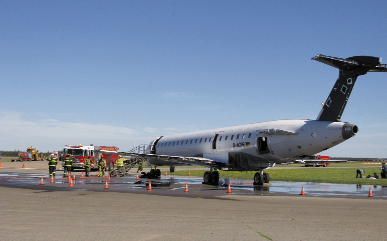Coordinating efforts
Full-scale emergency preparedness exercise held at Sawyer Airport

Fire crews respond to the simulated diaster scenario, spraying water and foam at the aircraft shell at Sawyer International Airport Saturday for a full-scale disaster simulation exercise. The airport conducts these full-scale disaster simulations every three years, per Federal Aviation Administration requirements, to ensure efforts of the many agencies involved are well-coordinated and efficient in responding to a disaster involving an aircraft. (Journal photo by Cecilia Brown)

By CECILIA BROWN
Journal Staff Writer
MARQUETTE — Fire crews, law enforcement, first responders, airport personnel and officials, volunteers who played crash victims, and many others gathered at Sawyer International Airport Saturday for a full-scale emergency preparedness exercise, which is held at the airport every three years, per Federal Aviation Administration requirements.
Saturday’s exercise simulated an aircraft disaster scenario, activating the airport’s full airport emergency plan and emergency operations center and mobilizing personnel who would respond to a real-life disaster situation, including staff from the airport, airlines, hospital, law enforcement agencies, central dispatch, and mutual aid.
Public Information Officer and Marquette County Administrator Scott Erbisch said the full-scale disaster simulation exercise is conducted to “make sure that we are prepared in the case of a serious emergency at the airport,” and demonstrate the airport’s readiness to handle such an incident.
This year, the triennial full-scale exercise was more realistic than ever — a newly-acquired 50-seat airplane shell, similar to the planes that regularly fly in and out of Sawyer, was used to simulate the exercise aircraft emergency.
“To be able to use a plane similar to what may actually be involved in an incident at Sawyer is an excellent way to do training,” Erbisch said, noting the airplane shell was “in essence donated by American Airlines,” for use in such exercises.
The use of the 50-seat airplane wasn’t the only new experience for the group of over 70 people who participated in the exercise Saturday– each year the triennial exercise is performed, the team goes through a different disaster scenario.
“We try to change them up a little bit each year, change the location, change the drill,” Erbisch said. “You don’t want to have it so routine, you want to be able to shake it up a little bit so that you’re still using your skills, but you’re using them in a different way.”
This year’s scenario simulated the aftermath of an incident between a plane and a drone, Erbisch said.
During Saturday’s exercise, Sawyer’s fire crew, as well as crews from Forsyth, West Branch, Sands and Skandia townships, responded to the scene with firetrucks and specialized crash trucks — numerous first responders performed firefighting and rescue efforts, utilizing firefighting equipment and carrying wounded victims, portrayed by volunteers, from the plane to an area with ambulances and medical personnel.
With so many agencies responding to an emergency, communication in such an incident is key, Erbisch said.
“The biggest part of this is communication, that’s one of the biggest challenges that you have when you have so many different jurisdictions,” Erbisch said, noting communication has gotten “better and better each time” the group performed the exercise.
After the exercise, the response was to be critiqued by an independent outside agency that gives feedback on the strengths and weaknesses of the response, airport officials said.
“We talk about what was good, and what was bad, and what we really need to work on for the future, so that’s what’s really important about this (process),” Erbisch said Saturday morning.
The group planned to go through the exercise and critique process twice Saturday.
“We’re going to do it once, come back here and have a debriefing, then we’re going to run it a second time,” said Joe Perry of Sawyer’s Aircraft Rescue and Fire Fighting Department. “So that way, if there are any problems this morning, we can work on those and get them figured out in the afternoon.”
This will allow personnel to get immediate feedback and correct any issues discovered in the first simulation on the same day, with another opportunity for feedback after the second full-scale exercise is done.
“If everything goes as planned, we will walk away better equipped to respond to a real-life incident or accident,” Airport Manager Duane DuRay said of the exercise in a previous Mining Journal article.
Steve Schenden, director of operations at Sawyer International Airport, said they appreciated the participation of all agencies, personnel and volunteers in the exercise, thanking the group for “donating their Saturday to really make sure that we keep the people flying in and out of this airport safe.”
Cecilia Brown can be reached at 906-228-2500, ext. 248. Her email address is cbrown@miningjournal.net.




